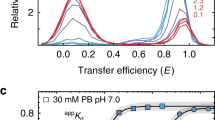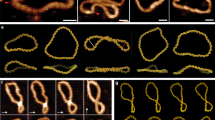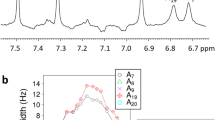Abstract
The solution structure of the human barrier-to-autointegration factor, BAF, a 21,000 Mr dimer, has been solved by NMR, including extensive use of dipolar couplings which provide a priori long range structural information. BAF is a highly evolutionarily conserved DNA binding protein that is responsible for inhibiting autointegration of retroviral DNA, thereby promoting integration of retroviral DNA into the host chromosome. BAF is largely helical, and each subunit is composed of five helices. The dimer is elongated in shape and the dimer interface comprises principally hydrophobic contacts supplemented by a single salt bridge. Despite the absence of any sequence similarity to any other known protein family, the topology of helices 3–5 is similar to that of a number of DNA binding proteins, with helices 4 and 5 constituting a helix-turn-helix motif. A model for the interaction of BAF with DNA that is consistent with structural and mutagenesis data is proposed.
This is a preview of subscription content, access via your institution
Access options
Subscribe to this journal
Receive 12 print issues and online access
$189.00 per year
only $15.75 per issue
Buy this article
- Purchase on Springer Link
- Instant access to full article PDF
Prices may be subject to local taxes which are calculated during checkout





Similar content being viewed by others
References
Katz, R.A. & Skalka, A.M. The retroviral enzymes. Annu. Rev. Biochem. 63, 133–173 (1994).
Brown, P.O., Bowerman, B., Varmus, H.E., and Bishop, J.M. Correct integration of retroviral DNA in vitro. Cell 49, 347–356 (1987).
Ellison, V., Abrams, H., Roe, T., Lifson, J., and Brown, P. Human immunodeficiency virus integration in a cell-free system. J. Virol. 64, 2711– 2715 (1990).
Farnet, C.M. and Haseltine, W.A. Integration of human immunodeficiency virus type 1 DNA in vitro. Proc. Natl. Acad. Sci. USA 87, 4164–4168 (1990).
Lee, M.S. & Craigie, R. Protection of retroviral DNA from autointegration: involvement of a cellular factor. Proc. Natl. Acad. Sci. USA 91, 9823–9827 (1994).
Lee, M.S. & Craigie, R. A previously unidentified host protein protects retroviral DNA from autointegration. Proc. Natl. Acad. Sci. USA 95, 1528–1533 ( 1998).
Clore, G.M., Gronenborn, A.M., Szabo, A. & Tjandra, N. Determining the magnitude of the fully asymmetric diffusion tensor from heteronuclear relaxation data in the absence of structural information. J. Am. Chem. Soc. 120, 4889–4890 ( 1998).
Clore, G.M. & Gronenborn, A.M. Structures of larger proteins in solution: three- and four-dimensional heteronuclear NMR spectroscopy. Science 252, 1390–1399 ( 1991).
Clore, G. M. & Gronenborn, A. M. Determining the structures of larger proteins and protein complexes by NMR. Trends Biotech. 16, 22–34 ( 1998).
Bax, A. & Grzesiek, S. Methdological advances in protein NMR Acc. Chem. Res. 26, 131– 138 (1993).
Tjandra, N., Omichinski, J. G., Gronenborn, A. M., Clore, G. M. & Bax, A. Use of dipolar 1H-15N and 1H-13C couplings in the structure determination of magnetically oriented macromolecules in solution. Nature Struct. Biol. 4, 732–728 (1997).
Pabo, C.O. & Sauer, R.T. Transcription factors: structural families and principles of DNA recognition. Annu. Rev. Biochem. 61, 1053–1095 ( 1992).
Schumacher, S. et al. Solution structure of the Mu end DNA-binding Iß subdomain of phage Mu transposase: modular DNA recognition by two tethered domains. EMBO J. 16, 7532– 7541 (1997).
Wilson, D.S., Guenther, B., Desplan, C. & Kuriyan, J. High-resolution crystal structure of a paired (PAX) class cooperative homeodomain dimer on DNA. Cell 82, 709– 719 (1995).
Luger, K., Maeder, A.W., Richmond, R.K., Sargent, D.F. & Richmond, T.J. X-ray structure of the nucleosome core particle at 2.8 Å resolution. Nature 389 , 251–259 (1997).
Xie, X. et al. Structural similarity between TAFS and the hetrotetrameric core of the histone octamer. Nature 380, 316– 322 (1996).
Cai, M. et al. An efficient and cost-effective isotope labeling protocol for proteins expressed in Escherichia coli. J. Biomol. NMR 11, 97–102 (1998).
Delaglio, F. et al. NMRPipe: a multidimensional spectral processing system based on UNIX pipes. J. Biomol. NMR 6, 277– 293 (1995).
Garrett, D. S., Powers, R., Gronenborn, A. M. & Clore, G. M. A common sense approach to peak picking in two-, three- and four-dimensional spectra using automatic computer analysis of contour diagrams. J. Magn. Reson. 95, 214–220 (1991).
Bax, A. et al. Measurement of homo- and hetero-nuclear J couplings from quantitative J correlation. Meth. Enz. 239, 79– 106 (1994).
Pelton, J.G., Torchia, D.A., Meadow, M.D. & Roseman, S. Tautomeric states of the active-site histidines of phosphorylated and unphosphorylated IIIGlc, a signal transducing protein from Escherichia coli , using two-dimensional heteronuclear NMR techniques. Protein Sci. 2, 543–558 ( 1993).
Tjandra, N. & Bax, A. Direct measurement of distances and angles in biomolecules by NMR in dilute liquid crystalline medium. Science 278, 1111–1114 ( 1997).
Ottiger, M., Delaglio, F. & Bax, A. Measurement of J and dipolar couplings from simplified two-dimensional NMR spectra. J. Magn. Reson. 131, 173–178 (1998).
Bewley, C.A. et al. Solution structure of cyanovirin-N, a potent HIV-inactivating protein. Nature Struct. Biol. 5, 571– 578 (1998).
Clore, G. M., Gronenborn, A. M. & Bax, A. A robust method for determining the magnitude of the fully asymmetric alignment tensor of oriented macromolecules in the absence of structural information. J. Magn. Reson. 133, 216–221 (1998).
Grzesiek, S. & Bax, A. The importance of not saturating H 2O in protein NMR: application to sensitivity enhancement and NOE measurements . J. Am. Chem. Soc. 115, 12593– 12594 (1993).
Tjandra, N., Wingfield, P.T., Stahl, S.J. & Bax, A. Anisotropic rotational diffusion of perdeuterated HIV protease from 15N NMR relaxation measurements at two magnetic fields. J. Biomol. NMR. 8, 273–284 ( 1996
Nilges, M. A calculational strategy for the structure determination of symmetric dimers by 1H-NMR. Proteins Struct. Funct. Genet. 17, 297–309 (1993).
Nilges, M., Gronenborn, AM., Brünger, A. T. & Clore G. M. Determination of three-dimensional structures of proteins by simulated annealing with interproton distance restraints: application to crambin, potato carboxypeptidase inhibitor and barley serine proteinase inhibitor 2. Prot. Engng. 2, 27–38 (1988).
Brünger, A.T. et al. Crystallography and NMR system (CNS): a new software suite for macromolecular structure determination. Acta Crystallogr. D in the press (1998).
Clore, G.M. & Gronenborn, A.M. New methods of structure refinement for macromolecular structure determination by NMR. Proc. Natl. Acad. Sci. USA 95, 5891–5898 (1998).
Clore, G. M., Gronenborn, A. M. & Tjandra, N. Direct structure refinement against residual dipolar couplings in the presence of rhombicity of unknown magnitude. J. Magn. Reson. 131, 159–162 (1998).
Brooks, B.R. et al. CHARMM: a program for macromolecular energy minimization and dynamics calculations. J. Comput. Chem. 4, 187–217 (1993).
Koradi, R., Billeter, M. & Wuthrich, K. MOLMOL: a program for display and analysis of macromolecular structures. J. Mol. Graph. 14 51-5, 29– 32 (1996).
Nichols, A., Sharp, K. A. & Honig, B. Protein folding and association: insights from the interfacial and thermodynamic properties of hydrocarbons. Proteins Struct. Funct. Genet. 11, 281–296 (1991).
Holm, L. & Sander, C. Protein structure comparison by alignment of distance matrices. J. Mol. Biol. 233, 123–138 (1993).
Laskowski, R. A., MacArthur, M. W., Moss, D. S. & Thornton, J. M. PROCHECK: A program to check the stereochemical quality of protein structures . J. Appl. Crystallogr. 26, 283– 291 (1993).
Acknowledgements
We thank D.S. Garrett and F. Delaglio for software support; R. Tschudin for hardware supprot; L. Pannel for mass spectrometry; M. Krause for deriving the C. elegans BAF sequence from genomic and EST sequences in the databases; and C. Bewley, D. Garrett, K. Frank, M. Ottiger and N. Tjandra for useful discussions. This work was supported by the AIDS Targeted Antiviral Program of the Office of the Director of the National Institutes of Health (G.M.C., A.M.G. and R.C.)
Author information
Authors and Affiliations
Corresponding authors
Rights and permissions
About this article
Cite this article
Cai, M., Huang, Y., Zheng, R. et al. Solution structure of the cellular factor BAF responsible for protecting retroviral DNA from autointegration. Nat Struct Mol Biol 5, 903–909 (1998). https://doi.org/10.1038/2345
Received:
Accepted:
Issue Date:
DOI: https://doi.org/10.1038/2345
This article is cited by
-
DNA unchained: two assays to discover and study inhibitors of the DNA clustering function of barrier-to-autointegration factor
Scientific Reports (2020)
-
High quality NMR structures: a new force field with implicit water and membrane solvation for Xplor-NIH
Journal of Biomolecular NMR (2017)
-
A simple and robust protocol for high-yield expression of perdeuterated proteins in Escherichia coli grown in shaker flasks
Journal of Biomolecular NMR (2016)
-
TALOS+: a hybrid method for predicting protein backbone torsion angles from NMR chemical shifts
Journal of Biomolecular NMR (2009)
-
Differential Complexation between Zn2+ and Cd2+ with Fulvic Acid: A Computational Chemistry Study
Water, Air, and Soil Pollution (2007)



